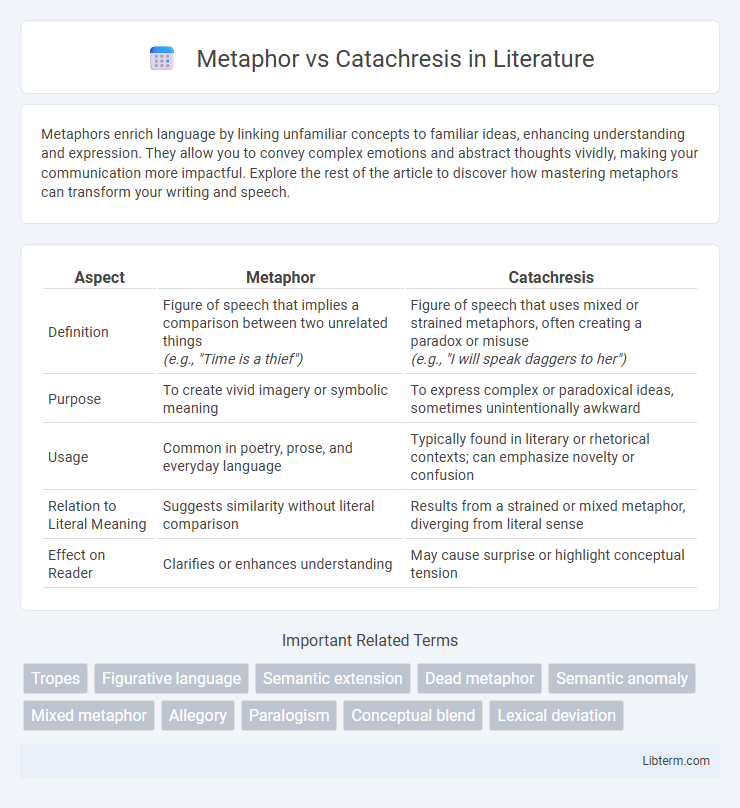Metaphors enrich language by linking unfamiliar concepts to familiar ideas, enhancing understanding and expression. They allow you to convey complex emotions and abstract thoughts vividly, making your communication more impactful. Explore the rest of the article to discover how mastering metaphors can transform your writing and speech.
Table of Comparison
| Aspect | Metaphor | Catachresis |
|---|---|---|
| Definition | Figure of speech that implies a comparison between two unrelated things (e.g., "Time is a thief") |
Figure of speech that uses mixed or strained metaphors, often creating a paradox or misuse (e.g., "I will speak daggers to her") |
| Purpose | To create vivid imagery or symbolic meaning | To express complex or paradoxical ideas, sometimes unintentionally awkward |
| Usage | Common in poetry, prose, and everyday language | Typically found in literary or rhetorical contexts; can emphasize novelty or confusion |
| Relation to Literal Meaning | Suggests similarity without literal comparison | Results from a strained or mixed metaphor, diverging from literal sense |
| Effect on Reader | Clarifies or enhances understanding | May cause surprise or highlight conceptual tension |
Introduction to Figurative Language
Metaphor and catachresis are key figures of speech within figurative language, where metaphor involves expressing one concept through the lens of another to create vivid imagery or understanding. Catachresis extends beyond standard metaphors by deliberately misusing or inventing terms to convey meaning in novel or paradoxical ways. Both devices enrich language by enabling nuanced expression that transcends literal interpretation, playing vital roles in literature, rhetoric, and everyday communication.
Defining Metaphor
Metaphor is a figure of speech that describes one thing by asserting it is another, highlighting similarities to create vivid imagery or clarify abstract concepts. It operates through implicit comparison, allowing audiences to understand complex ideas via familiar terms. Unlike catachresis, which involves the strained or paradoxical use of words, metaphor is characterized by intentional and meaningful representation.
Understanding Catachresis
Catachresis is a rhetorical device that involves the intentional misuse or strained use of words, often creating a paradoxical or mixed metaphor that challenges conventional language boundaries. Unlike metaphor, which draws clear comparisons between different concepts to enhance understanding, catachresis deliberately bends or breaks linguistic norms to evoke novel or surprising meanings. Understanding catachresis requires recognizing its role in expressing complex or abstract ideas where ordinary language falls short, often enriching literary and rhetorical expression through creative lexical innovation.
Key Differences: Metaphor vs Catachresis
Metaphor involves the direct comparison between two unrelated concepts to highlight similarities, often enhancing understanding through imaginative association. Catachresis, on the other hand, is the misuse or strained use of words, creating a paradoxical or mixed metaphor often perceived as a linguistic error or deliberate exaggeration. The key difference lies in metaphor's intentional clarity versus catachresis's deliberate distortion or confusion of meaning.
Historical Origins and Evolution
Metaphor originated in ancient Greek rhetoric, notably articulated by Aristotle as a transfer of meaning based on similarity, evolving through classical and medieval literature into a fundamental literary device. Catachresis emerged as an intentional misuse or strained metaphor, often arising when existing words lacked precise terms to describe novel or complex concepts, with roots traceable to rhetorical practices in the Renaissance. Both devices have evolved through centuries of linguistic innovation, shaping poetic expression and semantic expansion in diverse cultural contexts.
Functions in Literature and Rhetoric
Metaphor functions in literature and rhetoric by creating vivid imagery and fostering deeper understanding through symbolic substitution, enhancing emotional and cognitive engagement. Catachresis operates by deliberately stretching or breaking conventional language use, often generating heightened emphasis or provoking thought through unexpected or paradoxical expressions. Both devices contribute to stylistic richness and persuasive power but differ as metaphor relies on analogy while catachresis hinges on intentional linguistic misapplication.
Examples of Metaphor in Context
Metaphors create vivid imagery by directly comparing one thing to another, such as "Time is a thief," illustrating the abstract concept of time stealing moments from life. In literature, Shakespeare's phrase "All the world's a stage" exemplifies metaphor by equating life to a theatrical performance. This contrasts with catachresis, which involves the misuse or strained use of words, often creating a paradoxical or mixed metaphor like "I will speak daggers to her," blending contradictory ideas for rhetorical effect.
Notable Instances of Catachresis
Notable instances of catachresis include Shakespeare's famous phrase "blind mouths" in *Richard III*, where mouths cannot literally see but symbolize ignorant or unthinking speakers. Another example is Jonathan Swift's use of "I will speak daggers to her," blending conflicting domains to convey sharp verbal attacks. These instances highlight catachresis as a deliberate linguistic misuse creating powerful, often paradoxical imagery distinct from the metaphor's more conventional comparison.
Impact on Reader Interpretation
Metaphor enhances reader interpretation by creating vivid mental images that clarify complex concepts through relatable comparisons, facilitating deeper understanding and emotional engagement. Catachresis, often involving deliberate misuse or strained analogy, challenges readers to reconsider established meanings, provoking critical thought and highlighting linguistic creativity. Both devices shape cognitive and emotional responses, but metaphor tends to guide interpretation smoothly, whereas catachresis disrupts expectations to evoke surprise or emphasize tension.
Choosing Between Metaphor and Catachresis
Choosing between metaphor and catachresis depends on the intended clarity and creativity in language use. Metaphors rely on familiar associations to convey meaning by highlighting similarities between concepts, enhancing comprehension and relatability. Catachresis deliberately employs mixed or strained metaphors to create striking, unconventional expressions that challenge standard usage and provoke deeper reflection.
Metaphor Infographic

 libterm.com
libterm.com